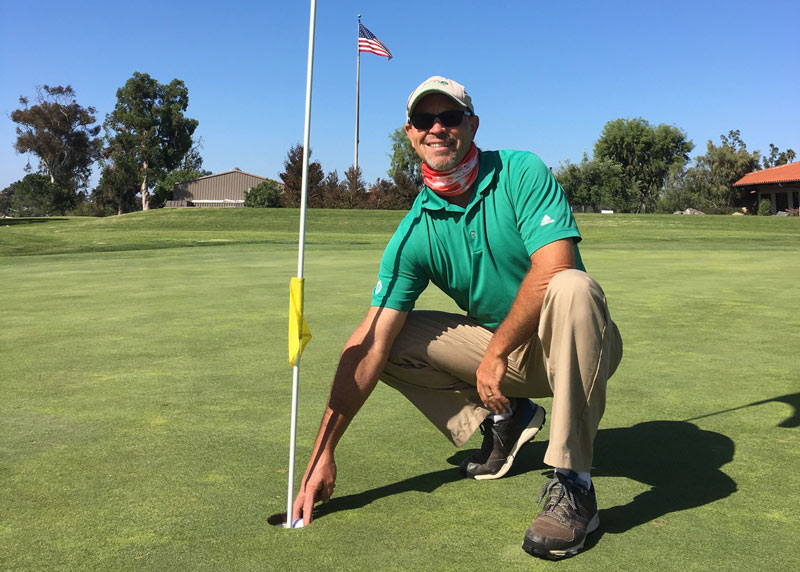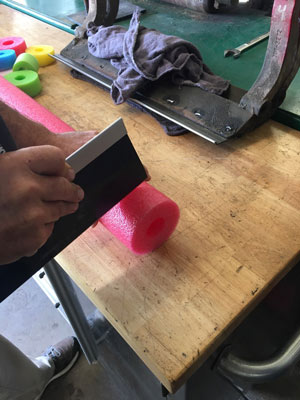
Last fall, Brendon Reaksecker, GCSAA Class A superintendent at Bonita (Calif.) Golf Course, saw the potential in pool noodles as a means of curbing cup wear and tear. Photo courtesy of Brendon Reaksecker
Brendon Reaksecker had been noodling on this idea awhile.
As he walked into Big 5 Sporting Goods in Chula Vista, Calif., last October, the golf course superintendent had only one purchase on his mind: a pool noodle.
“My brain’s always kind of turning. I was frustrated with hands reaching in the cup, banging it up, compromising it,” says Reaksecker, who oversees Bonita (Calif.) Golf Course near San Diego. “A lot of golfers ripped the ball out with their putter, messing up the cup instantly. My motivation was to keep the hole intact when our golf leagues start later in the day.”
His solution to protecting the cups from wear and tear? Those foam flotation toys.
Reaksecker, a GCSAA Class A superintendent and 21-year association member, could have never imagined then that his $2.99 investment in a green pool noodle would be a forerunner of an industry trend, albeit a trend that would catch on for quite different reasons.
Back in December 2019, Reaksecker and his friend and business partner, Jim Davis, hired an attorney to handle the U.S. patent for their course accessory, which they dubbed the Golf Cup Noodle, designed to mitigate the need to touch the cup or flagstick when retrieving one’s golf ball. They even paid extra to expedite the patent process.
Given the current circumstances, however, the idea has already taken off. And at lightning speed.
“The coronavirus turned it into a must-have overnight,” says Davis, a sales representative for Harrell’s. “The virus was never part of the thinking when Brendon came up with this. There is no forward thinking for something like that.”
As the coronavirus crisis began unfolding in the U.S. in March, GCM began compiling firsthand reports from superintendents about how they were adjusting their courses and operations. Several superintendents mentioned using pool noodles to eliminate golfer contact with cups and flagsticks.

A golf ball hovering in a cup, cushioned by Golf Cup Noodle. “Brendon invented this for an agronomic asset. This was all done before the coronavirus,” says Jim Davis, Reaksecker’s business partner. “I think it has enhanced the golfer’s experience.” Photo courtesy of Jim Davis
The rapid proliferation of the idea throughout the country (and on Twitter) has intrigued Reaksecker. “What is interesting about all of this is that the exposure and adoption of something could happen so fast. It’s cool — there’s no doubt about it,” he says.
When Davis visited Bonita GC and got his first look at Reaksecker’s brainchild last October, he says he was floored. “I told him, ‘You’ve got to be kidding me.’ I thought it was perfect,” Davis says. Their attorney told them to immediately pull the noodles from Bonita GC to protect their idea. “We knew we had something big when the patent lawyer said to get them out of sight,” Davis says. “He said anybody could file it (a patent); it doesn’t have to be the inventor. The first guy wins.”
After Reaksecker removed the pool noodles, he says golfers asked what had happened to them. “They really liked them,” he says.
So did other superintendents in the region. Reaksecker and Davis have already sold about a dozen to courses in the area.
During one of GCSAA’s town hall webinars in March, a photo of a pool noodle being used on a cup at a Missouri golf course was showcased as a modification to create a touch-free course. “I texted Brendon and said, ‘Can you believe this?’ It’s too small, too cheap, and easy to install. That’s why everybody is making them,” Davis says. “I’ve got no hard feelings that people are copying them. It’s more flattering than anything.”
Even though stopping the spread of a virus wasn’t the original intent of Golf Cup Noodle, the product does fit nicely with the touchless solutions being championed throughout the golf industry, including by Back2Golf, a collaborative effort by golf’s leading organizations (including GCSAA) that outlines best practices for course operations during the coronavirus pandemic. Golf Cup Noodle is also compliant with a recent change to the Rules of Golf, which no longer penalizes golfers if a ball played from the putting green hits a flagstick left in the hole. The USGA and R&A cited pace of play as one reason for the rule change. Now, with COVID-19, leaving the flagstick in has increased importance.
“I think this (Golf Cup Noodle, which Reaksecker reinstituted at Bonita GC in December after patent paperwork had been filed) has helped with pace of play,” Reaksecker says, noting that the reserved tee sheet of 309 golfers in one day last week is the most he’s seen in his 13 years at the public daily-fee course. “People, at least out here, aren’t touching the flagstick. Greens are clearing faster than they used to.”
On one occasion early in the process, Reaksecker brought some of his superintendent friends to play without informing them of his invention. “I put them (Golf Cup Noodles) on the back nine. A guy in my group said, ‘No way. Where did you get them?’” says Reaksecker.

Right: Reaksecker has a stash of multicolored pool noodles and plans to use particular colors for certain occasions, such as red and green during the holidays. Photo courtesy of Brendon Reaksecker
To use a pool noodle in a cup, Reaksecker uses a painter’s knife to slice a noodle 2 inches thick and 3-and-a-quarter inches in diameter. He then places it at the bottom of the cup (there is no anchor to it) and inserts the flagstick into the pre-cut center hole. “The pool noodle was the first thing I thought about on how to do this,” he says, “and it worked. It was so simple, so inexpensive. I made 18 of them, installed them on our course, and then sat back to see the response.”
Reaksecker has certainly learned a lot about the ins and outs of pool noodles. “The hole in the center of them is not always right in the center of them,” he says. “You have to look at it and not just go buy it. Also, the skin on the outside of them isn’t always the same density. I kind of laugh every time I buy a set. I learned a lot about pool noodles I didn’t care to know about.”
So far, Reaksecker estimates he’s spent less than $40 on pool noodles, and he says the current set of Golf Cup Noodles he’s using on his course are the ones he put out May 5. “Make sure they don’t wear out, tear or rip so it won’t cheapen the idea of the product,” he advises. “Keep them fresh.”
What does the future hold for Golf Cup Noodle? Reaksecker and Davis hope their patent is approved any day. Davis says he and Reaksecker could possibly approach golf accessory companies to see whether they would want to market it (other ideas for the product’s name were Lip Saver, Cup Saver and Golf Noodle). The pair has seen variations of the Golf Cup Noodle idea at other courses, including one that features PVC pipe and a shepherd’s hook. “I don’t know if we’ll cash in because everybody’s making their own,” Davis says.
Reaksecker, meanwhile, never envisioned this as a get-rich project. “I never got into it to make money. Hopefully, we make enough so Jim gets his (patent application fee) money back,” Reaksecker says. “What I just tried to do was create something to make my life and other superintendents’ lives easier and better. My business is to grow grass.”
Though Reaksecker laughs at the suggestion that he’s a visionary, he says he does hope Golf Cup Noodle remains viable. “It would be great when I retire as a superintendent 20 years from now to see them on televised golf and feel we contributed to part of the game,” he says. “That would be the ultimate.”
Bonus turf hack: The bunker feather
The idea is akin to a survey feather that’s used to mark athletic fields, construction sites, etc.
“The feathers are installed in the collection areas of the bunkers to monitor the depth of the sand. If the tip of the feather is visible, we know to redistribute the sand by raking or adding fresh sand,” Reaksecker says. “The feather can be pre-cut to the desired depth. A 4-inch depth works for the drainage characteristics of our sand. As an added bonus, the feathers help train the golfers and the maintenance team on proper raking technique. We want to keep the sand consistent and make it the best it can be for our customers.”
Howard Richman is GCM’s associate editor.